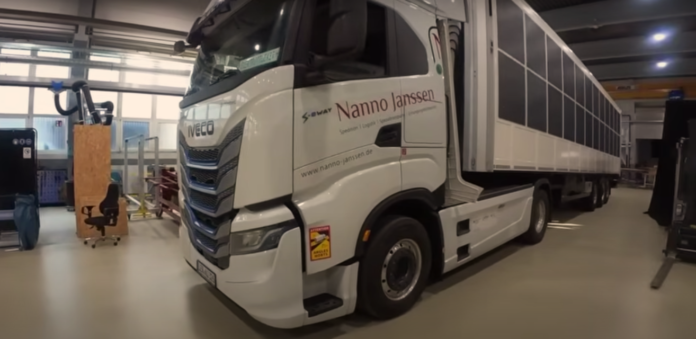Sign up for daily news updates from CleanTechnica on email. Or follow us on Google News!
News about electric vehicles tends to focus on personal transportation: cars, SUVs, pickup trucks, ebikes, electric motorcycles, etc. There are other electric vehicles, though, and great reasons they should be getting attention. Big trucks for shipping, using diesel engines, generate huge amounts of harmful air pollution. Replacing them with electric ones helps reduce that toxic air pollution. It also decreases diesel fuel purchases so that less money goes to fossil fuel corporations. Of course, there are also the greenhouse gas emissions.
Most of us are not truck drivers, so we are not familiar with the direct daily experiences of what it is like to drive a tractor trailer. When I saw a German truck driver showing such experiences in videos on YouTube, it was quite a window into driving electric big rigs. His name is Tobias and I was able to get some information from his team.
How did you become a truck driver?
About 8 months ago I quit my job at the startup “Charge X” I founded a few years ago that specialized in AC electric car charging infrastructure. I wanted to explore new aspects of E-Mobility and because I was always interested in being a truck driver, I decided to become one and drive electric trucks.
I got my license and afterwards applied for several logistics companies until I found “Nanno Janssen” stationed in “Leer” in northwest Germany, close to the border to the Netherlands. They specialize in national logistics but also occasionally have international routes around western Europe. They are one of the few companies who embraced electric trucks and ordered over 40 of them, of which most will be delivered in 2025. They also built their own charging park, a solar installation and 4MW battery. In Germany, over 95% of trucks are still diesel, so it’s very unique to work for such a company.
I did my license in a DAF diesel truck but since then I only drove electric. There were a few days where I had to switch and drive diesel or repark them in our yard but I haven’t done any long distance trucking with a diesel. But I enjoy driving electric so much more that I would not voluntarily switch to a diesel.
What electric trucks do you drive?
At Nanno Jannsen I’ve been driving a Volvo FM Electric, a Scania 40R and Iveco S-eWay. Additionally I could test drive the DAF XF Electric and the Mercedes eActros 600 at different events.
What do you like about electric trucks?
What I like about electric trucks and what are advantages over diesel is the instant and constant acceleration. Not only is it a lot more fun to drive, but it makes trucking a lot safer. You can accelerate faster onto the highway, overtake other trucks or cars quicker and therefore don’t block the road for others.
Another huge bonus is the absence of air and noise pollution. Many people aren’t aware of how unhealthy the diesel fumes are and especially when you are driving in the city, pedestrians are constantly breathing in diesel truck fumes. And noise pollution is even less talked about. I often drive late at night through cities or small villages, and the absence of a roaring diesel engine makes trucking a lot more pleasant for the driver, but so much more for all the people already sleeping or getting ready for bed.
Electric Trucks also have a lot less gears, or in the case of the Iveco I’m driving only one single gear, which is surprisingly relaxing while driving.
What is the range of your electric trucks?
There is always a huge debate about the range of electric trucks, similar to how it is to electric cars, but because trucking is a business that has a lot of regulations, people often don’t see the whole picture. In Germany there are driving times, rest times, and working time regulations.
After a maximum of 4.5 hours of driving I have to take a mandatory 45 minute break, regardless if I drive electric or diesel. During the break I can charge up the truck, rest, walk my dog and have a meal. The 45 minute break charges at least 30% of my truck’s battery, giving me another 150 km of range. Then I have to take a 2nd break after another 4.5 hours of driving, which usually ends my work day. At this 2nd break I can let the truck charge back up to 100% which gives me maximum flexibility for the next day. Then I repark the truck to not block the charging station and sleep in the cabin with my dog “Krümelix”.
With the Volvo FM Electric and its 540 kWh battery I get a range of around 350 km, with the Scania 40R (624 kWh) around 400 km and the Iveco S-eWay (738 kWh) around 500 km of range.
But in Germany or most of Europe, range is not the bottleneck of electric trucks, but driving and rest time regulations. Even when I drove long distance with the Volvo FM Electric, which has the smallest range and is only used in local transport, I managed to get to all my appointments in time and never was delayed because of the truck’s range.
But not every delivery is like that. Most of the time I have multiple loading and unloading spots. Unloading can take less than 30 minutes, but sometimes I have to wait or the load is hard to handle and it can take several hours. And all this is counted towards my maximum working hours of 15 hours per day, which means I rarely “need” to use up the battery because there is so much more involved with the job than just driving.
The only issue that I’m still facing is the unreliability of the charging network across Germany. Many chargers are broken, don’t deliver the maximum charging speed, or the charging parks themselves are not made for trucks. But there is also good news. Over the next years 350 truck charging parks are being built across Germany, which (hopefully) will make all the problems go away. And most charging providers already only use energy from renewables, which is also amazing in itself.
But despite all the current shortcomings, I’m still able to hit all my appointments and was never stranded, so it’s possible today to go electric as a logistics company, as long as you do a bit of research about charging infrastructure and charging locations.
And I want to be part of the coming change in the industry. I want to educate people through YouTube and I’ve also developed an app specifically for electric truck drivers that makes it easier to find suitable charging stations while accounting for rest and driving time regulations.
And while the current state of electric trucks is not suitable in countries like the US or Australia, because of different rest time regulations and longer distances to drive, electric trucks are still improving and once the MCS (Megawatt Charging System) becomes standard, and trucks can charge 20 to 80% within less than 30 minutes, giving them another 300–400 km of range, there will be a lot more use cases all over the world.
And at the end of the day, logistics companies care about what is most profitable. Charging might be more inconvenient time-wise, but if it lowers maintenance costs by more than the additional working time, logistics companies will switch to electric.


